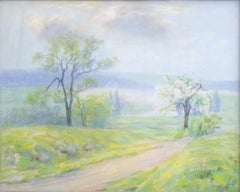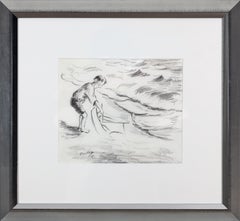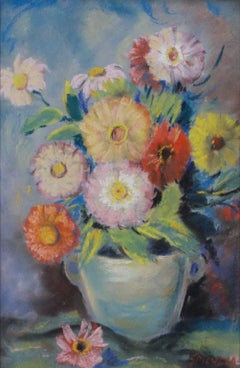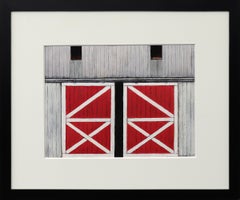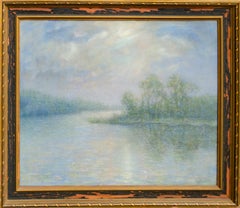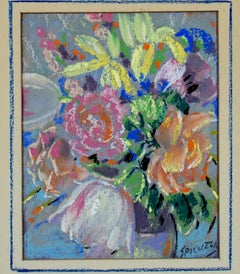Francesco Spicuzza Drawings and Watercolor Paintings
Italian, American, 1883-1962
Italian-born Francesco Spicuzza was primarily a Wisconsin painter who did portraits, still-lives and local landscapes. He spent the first part of his life in near-poverty to become a painter. An eternal optimist, in 1917, the artist reported: "I am happy and my only ambition now is to paint better and better until I shall have reached the measure of the best of which I am capable." (Spicuzza, 1917, p. 22). His predilection for beach scenes germinated early: reportedly, the five-year-old boy first drew the outlines of his father's fishing boat in the sand on the seashore near their home in Sicily. After setting himself up as a fruit peddler in Milwaukee, Spicuzza's father sent for his family when Francesco was eight years old.
In 1899 or 1900, Spicuzza began studying drawing and anatomy under Robert Schade (1861-1912), a painter of panoramas who had been trained in Munich under Carl Theodor von Piloty. Spicuzza was also taught by Alexander Mueller (1872-1935), a product of the Weimar and Munich academies.
The earliest influences in his work appear to be from Edward H. Potthast and Maurice Prendergast, though Spicuzza never mentioned either artist. Already in August 1910, Spicuzza was described in a newspaper as "one of the most talented of Milwaukee's rising workers." He undoubtedly received lasting inspiration from his one summer study period in 1911 with John F. Carlson at the Art Students League's Summer School in Woodstock, New York. Although he executed numerous still-lives and an occasional religious work, Spicuzza is best known for his Milwaukee beach scenes populated with frolicking bathers in multi-colored attire, not unlike the images of Potthast, who used a similar technique. These beach genre scenes reflect the attitude of American impressionists who depicted the more pleasant side of life.
Spicuzza manipulated a successful balance of rich pigment applied in varying degrees of impasto texture with subtle nuances of hue. Working all'aperto, he sought "the soft enticing shades of yellow, blue, green, pink and lavender . . . to get the effects of bright glistening summer air." (L.E.S., n.d.). As a painter whose color not only derived from direct observation but also from a personal theory of color symbolism, Spicuzza traded the linear approach of lithography for dynamic patches of brilliant color. Like Prendergast, he would often tilt the angle of the picture plane to bring the viewer's position above the scene.
Spicuzza spent a great deal of time painting en plein air and by 1925 he began summering at Big Cedar Lake, near West Bend, Wisconsin to gather his subject matter. During the difficult era of the Depression, patrons came to Spicuzza's aid and during the 40s, he taught housewives, businessmen and students at the Milwaukee Art Institute, the Milwaukee Art Center, and in his studio. In the following decade, although his kind of art was no longer popular in the "make-it-or-break-it" New York gallery world, Spicuzza enjoyed regular patronage and sales.
Bio by Richard H. Love and Michael Preston Worley, Ph.D.(Biography provided by J Gold Fine Art)
to
6
2
1
3
3
2
2
2
Overall Height
to
Overall Width
to
1
5
3
2
2
2
1
1
1
1
1
1
1
1
6
1
1
1
1
17
758
412
288
228
3
3
3
3
2
Artist: Francesco Spicuzza
Beautiful large impressionist pastel by Francesco Spicuzza
By Francesco Spicuzza
Located in Larchmont, NY
Francesco Spicuzza (American, 1883-1962)
Untitled Landscape, 20th century
Pastel on paper
Sight size: 24 x 30 in.
Framed: 26 1/4 x 32 3/8 in.
Signed lower right: Spicuzza
Italian-born Francesco Spicuzza was primarily a Wisconsin painter who did portraits, still-lives and local landscapes. He spent the first part of his life in near-poverty to become a painter. An eternal optimist, in 1917, the artist reported: "I am happy and my only ambition now is to paint better and better until I shall have reached the measure of the best of which I am capable." (Spicuzza, 1917, p. 22). His predilection for beach scenes germinated early: reportedly, the five-year-old boy first drew the outlines of his father's fishing boat in the sand on the seashore near their home in Sicily. After setting himself up as a fruit peddler in Milwaukee, Spicuzza's father sent for his family when Francesco was eight years old. For the following six years the boy was unable to attend school because of his job in his father's fruit and vegetable business. The poor lad suffered a caved-in shoulder from carrying a heavy wooden crate.
The young Spicuzza was aided by moral and financial support from a sympathetic Milwaukee businessman named John Cramer, publisher and editor of the Evening Wisconsin, who raised Spicuzza's salary as a newspaper assembler so that he could attend school. In 1899 or 1900, Spicuzza began studying drawing and anatomy under Robert Schade (1861-1912), a painter of panoramas who had been trained in Munich under Carl Theodor von Piloty. Spicuzza was also taught by Alexander Mueller (1872-1935), a product of the Weimar and Munich academies. Mueller realized Spicuzza was a colorist and encouraged that orientation (Madle, 1961). Spicuzza found it beneficial to accept an apprenticeship in a lithographic studio for $8 a week, which demanded most of his time. During the St. Louis Universal Exposition in 1904, still a struggling student, Spicuzza attended the fair, thanks to Cramer. It was not long before Spicuzza received a twenty-five dollar portrait commission, and this inaugural success led to new commissions and allowed him to continue as a painter.
The earliest influences in his work appear to be from Edward H. Potthast and Maurice Prendergast, though Spicuzza never mentioned either artist. Already in August 1910, Spicuzza was described in a newspaper as "one of the most talented of Milwaukee's rising workers." He undoubtedly received lasting inspiration from his one summer study period in 1911 with John F. Carlson at the Art Students League's Summer School in Woodstock, New York. Certainly Spicuzza would have picked up spontaneity in handling the brush from Carlson. Although he executed numerous still-lives and an occasional religious work, Spicuzza is best known for his Milwaukee beach scenes populated with frolicking bathers in multi-colored attire, not unlike the images of Potthast, who used a similar technique. Many of these are small, preparatory works on canvas board executed between 1910 and 1915. Frequently with even greater animation than Potthast, Spicuzza produced moving images of youthful energy and uninhibited child's play. These beach genre scenes reflect the attitude of American impressionists who depicted the more pleasant side of life.
Spicuzza manipulated a successful balance of rich pigment applied in varying degrees of impasto texture with subtle nuances of hue. Working all'aperto, he sought "the soft enticing shades of yellow, blue, green, pink and lavender . . . to get the effects of bright glistening summer air." (L.E.S., n.d.). As a painter whose color not only derived from direct observation but also from a personal theory of color symbolism, Spicuzza traded the linear approach of lithography for dynamic patches of brilliant color. Like Prendergast, he would often tilt the angle of the picture plane to bring the viewer's position above the scene.
Spicuzza was unable to enter the 1913 Armory Show or the Panama-Pacific International Exposition two years later but he did submit work to the annual exhibitions of the Pennsylvania Academy of the Fine Arts and those of the Art Institute of Chicago. His first important award was the bronze medal presented by the St. Paul Institute in 1913, which was followed by the silver medal two years later. Before long, Spicuzza had acquired a greater sense of security in his profession and was described by a writer in International Studio (April 1917) as "an independent artist with an assured future. His pastels and water-colours are poetic and joyous bits of nature with a genuine out-of-door feeling." In 1918, his Spirit of Youth, exhibited at the National Academy of Design, sold for $112.50. Four years later, the artist achieved his greatest local recognition by winning the gold medal from the Milwaukee Art Institute.
Spicuzza spent a great deal of time painting en plein air and by 1925 he began summering at Big Cedar Lake, near West Bend, Wisconsin to gather his subject matter. Easter Morning (1926) owes something to the Symbolist movement, with its figure of Christ appearing over a seascape. During the difficult era of the Depression, patrons came to Spicuzza's aid and during the 40s, he taught housewives, businessmen and students at the Milwaukee Art Institute, the Milwaukee Art Center, and in his private studio. In the following decade, although his kind of art was no longer popular in the "make-it-or-break-it" New York gallery world, Spicuzza enjoyed regular patronage and sales. His beach scenes became more static and he would experiment with modernist techniques. Spicuzza died at the age of seventy-eight.
Sources:
L.E.S., "Do Colors Change a Person's disposition? Experiments of a Milwaukee Artist...
Category
20th Century American Modern Francesco Spicuzza Drawings and Watercolor Paintings
Materials
Paper, Pastel
Boy Launching a Sailboat
By Francesco Spicuzza
Located in Milwaukee, WI
Graphite and charcoal on paper signed by the artist.
7.38" x 8.63"
16.75" x 15.5" frame
Framed to conservation standards. Float mounted on 100% cotton matboard and glazed in UF5 Plexiglass that filters 99% of UV Rays to ensure the preservation of the piece. All housed in a bold miter jointed bevel frame in distressed silver finish with reflective accents.
Francesco J. Spicuzza, born in Sicily on July 23, 1883, came to America at the age of 8. He supported himself as a fruit peddler until a newspaperman gave him $4 a week to go to school. He attended classes at the Milwaukee Art Students League, where he studied under Alexander Mueller. There he learned to paint in the then-fashionable "Munich School" technique, with detailed realism in heavy browns and grayed-out hues. Spicuzza completed eight grades in four years, and then in 1911, three businessmen advanced him enough money to allow him to study in New York under artist and teacher John Carlson.
It was during this time that Spicuzza changed his style of painting, developing an impressionistic use of color, form and atmospheric renditions. After a period of grinding poverty, one of Spicuzza's pictures won a major New York competition. It was the first of 60 wins, both in the U.S. and Paris. He became a fashionable painter, and many of the leading collections have his work. Spicuzza's typical works were beach scenes, still life, landscapes and portraits done in pastels, oils, ink, charcoal and watercolors. Much of his work traced the history of Milwaukee in the early 1900s. He was probably best known for his scenes of women and children splashing in the waves...
Category
Mid-20th Century Francesco Spicuzza Drawings and Watercolor Paintings
Materials
Graphite, Charcoal
"Flowers in Vase with Handles, " Pastel on Paperboard signed by F. Spicuzza
By Francesco Spicuzza
Located in Milwaukee, WI
"Flowers in Vase with Handles" is an original pastel drawing on paperboard by Francesco Spicuzza. The artist signed the piece in the lower right. This drawing depicts a bouquet of wa...
Category
1930s Francesco Spicuzza Drawings and Watercolor Paintings
Materials
Pastel, Board, Paper
"Lake Michigan Bathers, " Pencil, Reverse, & Photo signed by Francesco Spicuzza
By Francesco Spicuzza
Located in Milwaukee, WI
"Lake Michigan Bathers" is an original pencil sketch by Francesco Spicuzza. The artist signed the piece in the lower right. On the reverse is a silver gelatin photo print...
Category
1910s Francesco Spicuzza Drawings and Watercolor Paintings
Materials
Black and White, Silver Gelatin, Carbon Pencil
"Monkey Island at Washington Park Zoo" Graphite & Charcoal by Francesco Spicuzza
By Francesco Spicuzza
Located in Milwaukee, WI
"Monkey Island at Washington Park Zoo" is an original graphite and charcoal drawing on paper by Francesco Spicuzza. It depicts a number of figures gazing out at a monkey enclosure at a zoo. The artist signed the piece in the lower left.
8 1/2" x 11 3/4" art
17 1/4" x 21 1/8" frame
Francesco J. Spicuzza, born in Sicily on July 23, 1883, came to America at the age of 8. He supported himself as a fruit peddler until a newspaperman gave him $4 a week to go to school. He attended classes at the Milwaukee Art Students League, where he studied under Alexander Mueller. There he learned to paint in the then-fashionable "Munich School" technique, with detailed realism in heavy browns and grayed-out hues. Spicuzza completed eight grades in four years, and then in 1911, three businessmen advanced him enough money to allow him to study in New York under artist and teacher John Carlson. It was during this time that Spicuzza changed his style of painting, developing an impressionistic use of color, form and atmospheric renditions. After a period of grinding poverty, one of Spicuzza's pictures won a major New York competition. It was the first of 60 wins, both in the U.S. and Paris. He became a fashionable painter, and many of the leading collections have his work. Spicuzza's typical works were beach scenes, still life, landscapes and portraits done in pastels, oils, ink, charcoal and watercolors. Much of his work traced the history of Milwaukee in the early 1900s. He was probably best known for his scenes of women and children splashing in...
Category
1950s Francesco Spicuzza Drawings and Watercolor Paintings
Materials
Charcoal, Graphite, Paper
"Portrait of the Artist's Mother-In-Law, " Pastel signed by Francesco Spicuzza
By Francesco Spicuzza
Located in Milwaukee, WI
"Portrait of the Artist's Mother-in-Law" is an original pastel drawing by Francesco Spicuzza. The artist signed the piece in the lower right. This drawing depicts an elderly woman in beige clothing...
Category
Early 1900s Francesco Spicuzza Drawings and Watercolor Paintings
Materials
Pastel
Related Items
Paul Schürch (1886-1939) - Romantic Landscape Drawing 1917 Solothurn Switzerland
Located in Meinisberg, CH
Paul Schürch
(Swiss, ∗ 14.2.1886 Wangen b. Olten, † 11.12.1939 Bern)
Romantic Landscape in area of Solothurn, Switzerland
• Charcoal/Pencil drawing delicately heightened in various...
Category
1910s Naturalistic Francesco Spicuzza Drawings and Watercolor Paintings
Materials
Laid Paper, Pencil, Pastel, Charcoal
Free Shipping
H 11.42 in W 17.92 in D 0.16 in
American Modernist Oil Stick Drawing, Gray Barn With Red Sliding Doors Landscape
Located in Denver, CO
Oil stick on paper titled "Barn Side with Sliding Doors" by George Vander Sluis (1915-1984) of a grey wooden barn with two windows as well as two r...
Category
1980s American Modern Francesco Spicuzza Drawings and Watercolor Paintings
Materials
Oil Pastel, Paper
G. A. Rochegrosse (1859-1938) A zither player, small signed drawingdrawing
By Georges Antoine Rochegrosse
Located in Paris, FR
Georges Antoine Rochegrosse (1859-1938)
A zither player
carbon pencil on thin paper
8.5 x 3.3 cm
In good condition
Framed : 35 x 24 cm
Provenance: Estate of the artist and by Inher...
Category
1910s Symbolist Francesco Spicuzza Drawings and Watercolor Paintings
Materials
Carbon Pencil
Sans titre I
By Francine Auvrouin
Located in Paris, FR
one of a kind drawing.
Category
21st Century and Contemporary Contemporary Francesco Spicuzza Drawings and Watercolor Paintings
Materials
Pastel, Charcoal
Theophile Alexandre Steinlen (1859-1923) Men at the Pont du Carrousel, drawing
By Théophile Alexandre Steinlen
Located in Paris, FR
Theophile Alexandre Steinlen (1859-1923)
Men at the Pont du Carrousel,
Signed "St" on the lower right
pencil on paper
9 x 15 cm
framed : 24,5 x 30 cm
In good condition, slightly ye...
Category
1890s Impressionist Francesco Spicuzza Drawings and Watercolor Paintings
Materials
Carbon Pencil
Village Northern Bali, 1906
Located in Amsterdam, NL
Premises in North Bali, 1906
Signed with initials and titled bottom left and fully signed, bottom right
Pencil and ink on paper, 10.5 x 18 cm
Black ebonized frame with white mount
...
Category
Early 1900s Art Nouveau Francesco Spicuzza Drawings and Watercolor Paintings
Materials
Graphite, Paper
Portrait of artist Ida Bagoes Ketut Diding, Bali, 1937
Located in Amsterdam, NL
Ida Bagoes Ketut Diding, Artist on bali 1937
Signed with initials, dated and titled, bottom centre
Black chalk on paper, 29 x 31 cm
Literature:
Ernst Braches en J.F. Heijbroek, W....
Category
1930s Art Nouveau Francesco Spicuzza Drawings and Watercolor Paintings
Materials
Graphite, Paper
Free Shipping
H 11.42 in W 12.21 in D 1.19 in
Baobab N5 by Calo Carratalá - Work on paper, graphite drawing, tree, Africa
By Calo Carratalá
Located in Paris, FR
Baobab N5 is a unique graphite on paper mounted on a wood frame drawing by contemporary artist Calo Carratalá, dimensions are 65 × 46 cm (25.6 × 18.1 in). Dimensions of the framed ar...
Category
2010s Contemporary Francesco Spicuzza Drawings and Watercolor Paintings
Materials
Paper, Graphite
BANANA (ORIGINAL DRAWING)
By David Hockney
Located in Aventura, FL
Original colored crayons and pastel drawing on paper. Hand signed and dated on front by David Hockney. Artwork size 16.75 x 14inches. Frame size approx 27 x 24 inches. Provenance...
Category
1980s Pop Art Francesco Spicuzza Drawings and Watercolor Paintings
Materials
Paper, Crayon, Pastel
Intérieur Provence, Realistic Figurative original Drawing, Colorful, Interior
Located in AIX-EN-PROVENCE, FR
Coloured Pencils and pastel on Hahnemühle paper - Realistic Figurative original Drawing, Colorful, Interior.
Work Title : Intérieur Provence
Artist : Gabriel Riesnert...
Category
21st Century and Contemporary Contemporary Francesco Spicuzza Drawings and Watercolor Paintings
Materials
Watercolor, Archival Paper, Color Pencil, Pastel
H 6.3 in W 5.91 in D 0.08 in
William Jacobs "Urban Scene II", original pastel on paper
By William Jacobs
Located in Glenview, IL
"Urban Scene II" by noted Chicago painter William Jacobs (1897 - 1973) is a pastel on paper created in 1972. The artwork is signed and dated in pencil by t...
Category
1970s American Modern Francesco Spicuzza Drawings and Watercolor Paintings
Materials
Pastel
H 5 in W 7 in D 0.01 in
Academic Drawing. Figure Study of Young Sitting Nude Man. 19th Century.
Located in Firenze, IT
Charcoal drawing on light gray-blue colored paper.
The drawing depicts a young man sitting with the
hand on forehead. the position is probably meant to express the feeling of regret,...
Category
19th Century Academic Francesco Spicuzza Drawings and Watercolor Paintings
Materials
Steel
Free Shipping
H 19.3 in W 12.6 in D 0.08 in
Previously Available Items
Lovely impressionist landscape in pastel by Francesco Spicuzza
By Francesco Spicuzza
Located in Larchmont, NY
Francesco Spicuzza (American, 1883-1962)
Untitled Landscape, 20th century
Pastel on paper
Sight size: 25 x 29 1/2 in.
Framed: 30 3/4 x 35 1/2 in.
Signed lower right: Spicuzza
Italian-born Francesco Spicuzza was primarily a Wisconsin painter who did portraits, still-lives and local landscapes. He spent the first part of his life in near-poverty to become a painter. An eternal optimist, in 1917, the artist reported: "I am happy and my only ambition now is to paint better and better until I shall have reached the measure of the best of which I am capable." (Spicuzza, 1917, p. 22). His predilection for beach scenes germinated early: reportedly, the five-year-old boy first drew the outlines of his father's fishing boat in the sand on the seashore near their home in Sicily. After setting himself up as a fruit peddler in Milwaukee, Spicuzza's father sent for his family when Francesco was eight years old. For the following six years the boy was unable to attend school because of his job in his father's fruit and vegetable business. The poor lad suffered a caved-in shoulder from carrying a heavy wooden crate.
The young Spicuzza was aided by moral and financial support from a sympathetic Milwaukee businessman named John Cramer, publisher and editor of the Evening Wisconsin, who raised Spicuzza's salary as a newspaper assembler so that he could attend school. In 1899 or 1900, Spicuzza began studying drawing and anatomy under Robert Schade...
Category
20th Century American Modern Francesco Spicuzza Drawings and Watercolor Paintings
Materials
Paper, Pastel
H 30.75 in W 35.5 in D 0.75 in
"Floral, " Pastel Vivid Still-life of Flowers signed by Francesco Spicuzza
By Francesco Spicuzza
Located in Milwaukee, WI
"Floral" is an original pastel drawing on paper by Francesco Spicuzza, signed in the lower right. The piece is a still life, a bouquet of flowers in a vase on the table. The perspec...
Category
1920s Modern Francesco Spicuzza Drawings and Watercolor Paintings
Materials
Paper, Pastel
"Boy Launching Toy Sailboat 353, " Original Graphite signed by Francesco Spicuzza
By Francesco Spicuzza
Located in Milwaukee, WI
"Boy Launching Toy Sailboat #353" is an original graphite drawing on paper by Francesco Spicuzza, stamped with his signature in the lower left. Executed i...
Category
1940s Modern Francesco Spicuzza Drawings and Watercolor Paintings
Materials
Paper, Graphite
Flowers in Blue Vase
By Francesco Spicuzza
Located in Milwaukee, WI
"Flowers in Blue Vase" is an original pastel drawing on paperboard by Francesco Spicuzza. The artist signed the piece in the lower right. This dra...
Category
1930s Francesco Spicuzza Drawings and Watercolor Paintings
Materials
Paper, Pastel, Board
Francesco Spicuzza drawings and watercolor paintings for sale on 1stDibs.
Find a wide variety of authentic Francesco Spicuzza drawings and watercolor paintings available for sale on 1stDibs. You can also browse by medium to find art by Francesco Spicuzza in crayon, paper, pastel and more. Much of the original work by this artist or collective was created during the 20th century and is mostly associated with the modern style. Not every interior allows for large Francesco Spicuzza drawings and watercolor paintings, so small editions measuring 13 inches across are available. Customers who are interested in this artist might also find the work of Charles Ragland Bunnell, William Thon, and Emil Bisttram. Francesco Spicuzza drawings and watercolor paintings prices can differ depending upon medium, time period and other attributes. On 1stDibs, the price for these items starts at $2,025 and tops out at $10,100, while the average work can sell for $2,500.
